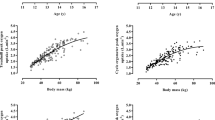Summary
A random sample of schoolchildren, 119 boys and 153 girls, was tested in the fall of 1983. The data presented here are anthropometric data (height, weight, fat % and vital capacity) and oxygen uptake directly measured on a bicycle ergometer. The mean height and weight for boys were 179.1 cm and 67.7 kg, and those for girls were 168.0 cm and 59.6 kg. The mean fat content was 9.1% for boys and 19.1% for girls, and their mean vital capacities were 4.91 and 3.61 respectively. The boys had a high maximal oxygen uptake (51.7 ml · kg−1 · min−1) showing no reduction over the age span studied. The girls' maximal oxygen uptake was lower (overall mean 40.0 ml · kg−1 · min−1) with a small reduction from 16 to 19 years of age. When comparing maximal oxygen uptake per kg lean body mass in the two sexes, the boys had 18.4% higher values than the girls, indicating that girls of this age have the lower fitness level. The results of maximal aerobic power measurement in the boys compare well with findings from other investigations using direct measurements, indicating that the fitness of teenage boys is kept at a high level. Comparable data from various countries for girls show different pictures, but it appears that in general they have a low fitness level.
Similar content being viewed by others
References
Andersen LB, Henckel P (1986) Maximal isometric muscle strength in Danish adolescents 16–19 years of age. Eur J Appl Physiol (in press)
Asmussen E, Heebøll-Nielsen K (1955) A dimentional analysis of physical performance and growth in boys. J Appl Physiol 7:593–603
Bink B, Wafelbakker F (1968) Physical working capacity at maximum levels of work, of boys 12–18 years of age. Ärztl Fortbild 62:957–961
Burmeister W, Rutenfranz J, Sbresny W, Radny HG (1972) Body cell mass and physical performance capacity (W 170) of schoolchildren. Int Z Angew Physiol 31:61–70
Døbeln von W (1956b) Maximal oxygen intake, body size, and total hemoglobin in normal man. Acta Physiol Scand 38:193
Døbeln von W (1956a) Human standard and maximal metabolic rate in relation to fat-free body mass. Act Physiol Scand [Suppl 126] 37
Døbeln von W, Åstrand I, Bergstrom A (1967) An analysis of age and other factors related to maximal oxygen uptake. J Appl Physiol 22:934
Engstrøm L-M (1975) Fysisk aktivitet under ungdomsåren, Ph. D. Thesis. Pedagogiska Institutionen, Lararhogskolan, Stockholm
Henriksson J, Retiman JS (1977) Time course of changes in human skeletal muscle succinate dehydrogenase and cytochrome oxidase activities and maximal oxygen uptake with physical activity and inactivity. Acta Physiol Scand 99:91–97
Hermansen L, Saltin B (1969) Oxygen uptake during maximal treadmill and bicycle exercise. J Appl Physiol 26:31
Hermansen L, Døbeln W von (1971) Body fat and skinfold measurements. Scand J Clin Lab Invest 27:315–319
Hettinger T, Birkhead WC, Horvath SM, Issekutz B, Rodahl K (1961) Assessment of physical work capacity. J Appl Physiol 16:153–159
Ingjer F (1979) Effects of endurence training on muscle fibre ATP-ase activity, capillary supply and mitochondrial content in man. J Physiol 294:419–432
Kavanagh T, Shephard RJ (1976) Maximum exercise test on postcoronary patients. J Appl Physiol 40:611
Klausen K, Andersen LB, Pelle I (1981) Adaptive changes in work capacity, skeletal muscle capillarization and enzyme levels during training and detraining. Acta Physiol Scand 113:9–16
Knuttgen HG (1967) Aerobic capacity of adolescents. J Appl Physiol 22:655–658
Lammert O (1975) L.U.S.K. undersøgelsen 1970–71. Tidsskr Legemsøvelser 5:170–181
Lange-Andersen K, Seliger V, Rutenfranz J, Mocellin R (1974) Physical performance capacity of children in Norway 1. Eur J Appl Physiol 33:177–195
Lange-Andersen K, Ilmarinen J, Rutenfranz J, Ottmann W, Berndt I, Kylian H, Ruppel M (1984) Leisure time sport activities and maximal aerobic power during late adolescence. Eur J Appl Physiol 52:431–436
MacDougall JD, Roche PD, Bar-Or O, Moroz JR (1983) Maximal aerobic capacity of canadian schoolchildren. Prediction based on age-related oxygen cost of running. Int J Sports Med 4:194–198
Nygård E (1981) Skeletal muscle fibre characteristics in young women. Acta Physiol Scand 112:299–304
Robinson S (1939) Experimental studies of physical fitness in relation to age. Arbeitsphysiologi 10:251–323
Rodahl K, Åstrand PO, Birkhead N, Hettinger T, Issekutz B, Jones M Jr (1961) Physical work capacity. Arch Environm Health 2:499–510
Rowell LB, Taylor HL, Wang Y (1964) Limitations to prediction of maximal oxygen uptake. J Appl Physiol 19:919
Saltin B, Gollnich PD (1983) Skeletal muscle adaptability: Significance for metabolism and performance. Chapter 19. In: Handbook of physiology, Peachey and Adrian Baltimore
Saltin B (1985) Hemodynamic adaptations to exercise. Am J Cardiol 55:42D-47D
Saris WHM (1982) Aerobic power of healthy 4–18 year old dutch children. Ph. D. Thesis. Katholieke Universiteit te Nijmegen
Schnohr P, Kahler H, Sørensen K (1977) Assessment of maximal aerobic power in 6527 inhabitants of Copenhagen. Ugeskr. Læger 139:3017–3019
Shephard RJ, Allen C, Benade AJS, Davies CTM, Prampero PE, Hedman R, Merriman JE, Myhre K, Simmons R (1968) The maximum oxygen intake. Bull Wld Health Org 38:757–764
Sloan AW, Koeslag JH, Bredell GAD (1973) Body composition, work capacity, and work efficiency of active and inactive young men. Eur J Appl Physiol 32:17–24
Sundberg S (1982) Maximal oxygen uptake in relation to age in blind and normal boys and girls. Acta Paediatr Scand 71:603–608
Taguchi S, Hata Y, Ikuta K, Miyashita M (1975) Age and sex trends in aerobic capacity related to lean body mass of Japanese from childhood to maturity. In Landry F, Orban WAR (eds) Exercise physiology. Symposia Specialists, Miami, pp 581–588
Åstrand I (1960) Aerobic work capacity in men and women with special reference to age. Acta Physiol Scand [Suppl 169] 49
Åstrand PO (1952) Experimental studies of physical working capacity in relation to sex and age. Munksgård, Copenhagen
Author information
Authors and Affiliations
Rights and permissions
About this article
Cite this article
Andersen, L.B., Henckel, P. & Saltin, B. Maximal oxygen uptake in Danish adolescents 16–19 years of age. Europ. J. Appl. Physiol. 56, 74–82 (1987). https://doi.org/10.1007/BF00696380
Accepted:
Issue Date:
DOI: https://doi.org/10.1007/BF00696380




